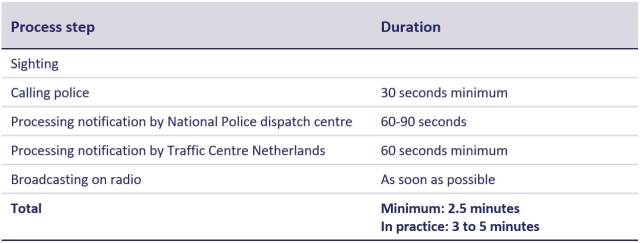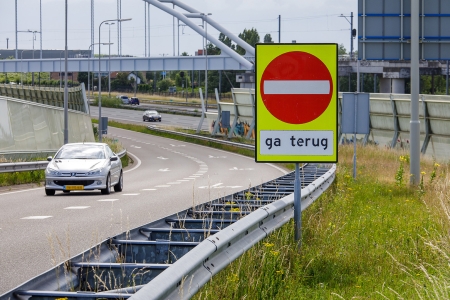Other measures that can help prevent wrong-way driving crashes include warning other traffic, general traffic management measures, driver-focused measures and in-vehicle technology.
Warning other traffic
In the Netherlands, when a wrong-way driver is reported, usually via the emergency number 112, all radio stations are broken into and road users are advised to ‘keep to the right, not to overtake and to warn the wrong-way driver by flashing the headlights.’ The information is also disseminated via navigation systems and traffic apps. Where matrix signs are present, lanes may be closed off with red crosses. Tunnels can generally be closed off with barriers.
This process obviously takes time. The Dutch Safety Board [27] estimates that it takes at least 2.5 minutes, but in practice 3 to 5 minutes, for a sighting of a wrong-way driver by another road user to be broadcast on radio (see Table 1). In that time, the wrong-way drive has usually already ended, whether or not in a crash, and if not, the wrong-way driver (at a speed of 120 km/h) is already some 6 kilometres away.

Table 2. Estimation of time from sighting to warning of a wrong-way driver (Source: [27])
Traffic management
In the late 1990s, there were also concrete proposals to completely clear the leftmost lane (where the wrong-way driver generally drives) when a wrong-way driver is reported, or to stop everyone at bridges or tunnels [28]. The (cost) effectiveness of these measures was never investigated and the measures were not introduced at the time. Meanwhile, new techniques have brought more possibilities. For example, many locations on the motorway network have cameras that can detect wrong-way drivers. In and near tunnels, a speed discrimination system (SDS) is sometimes installed that warns of stalled and slow-moving traffic, as well as wrong-way drivers. The question is, however, to what extent these methods can be used to react with sufficient reliability and speed to prevent a crash, for example by cordoning off a road section or tunnel (tube) (see, for example, [1] [29]).
Driver-focused measures
Relatively many wrong-way incidents and crashes occur because a driver is under the influence of alcohol, drugs or medication, or has mental health problems (see the question What are possible reasons for wrong-way driving?). Preventing people from driving under such circumstances will help reduce the number of wrong-way driving crashes [1]. In more general terms, this could include tackling alcohol and drug abuse and reducing the increasing pressure on mental health services. In addition, more specific measures in the field of medical fitness to drive and enforcement on alcohol and drug use in traffic can be considered.
In-vehicle technology
For years, the car industry has been working on technological solutions to the wrong-way driving problem: in-vehicle 'Wrong-Way Alert' or 'Wrong-Way Assistant'. Such systems aim to warn drivers (visually and aurally) if they are in danger of wrong-way driving, for example when entering an exit ramp. A number of car brands/types now have such systems operational, although sometimes only in a limited number of countries. These systems are usually based on GPS data combined with a navigation system. They also use built-in cameras that 'read' traffic signs. Research on the effectiveness of the systems is not known to us. There are also developments to use 'vehicle-to-vehicle' (V2V) communication to warn other drivers of an approaching wrong-way driver.
